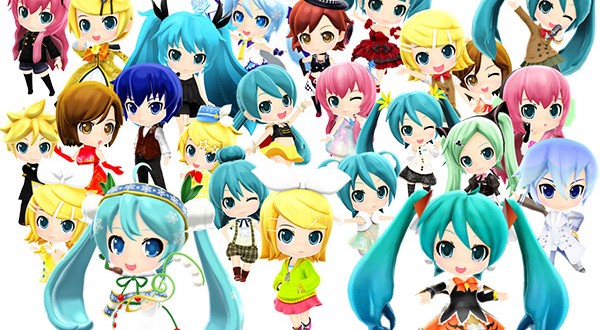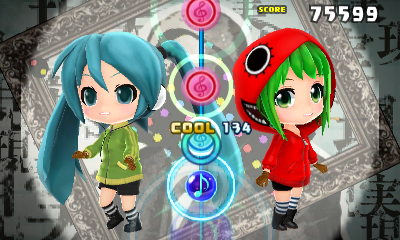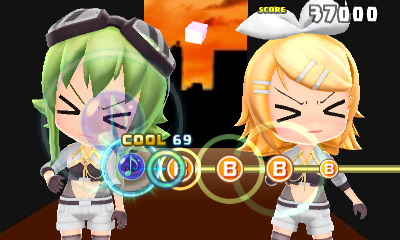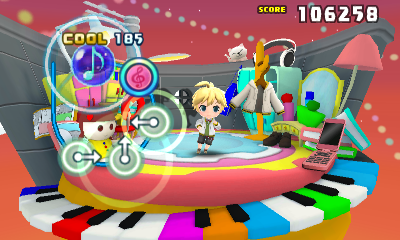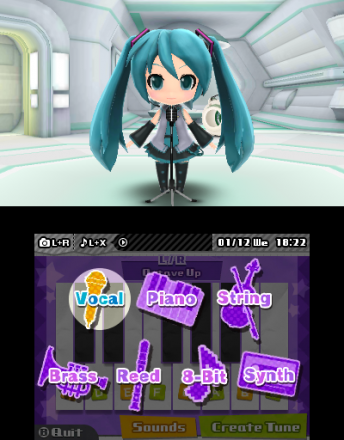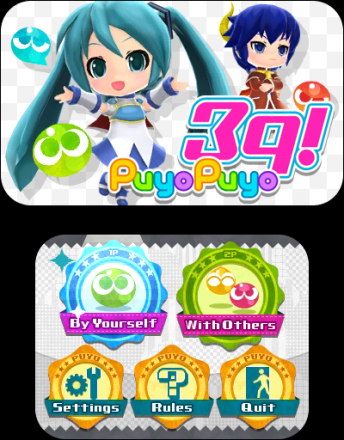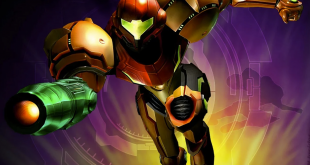Hatsune Miku: Project Mirai DX is, at its core, a rhythm game. However, it manages to be much more. Project Mirai DX is, all at once, a fashion game, a home design game, a choreography creator, a musical instrument, a reversi game, a rebirth of Puyo Puyo (or, if you prefer, Puyo Pop), an alarm clock (yes, really), a music video compilation, and a collection of great pop songs. There’s more to do here than there is in most rhythm games, and the entire package is sure to bring a smile to your face.
If you don’t already know, Hatsune Miku (初音ミク) is a vocaloid created by Crypton Future Media in 2007. Miku was released as a singing synthesizer software, but she has become much more than that. Since her creation, Miku has taken on a life of her own, developing a signature look, a vivid personality, a style of clothing, and established a group of friends who have done the same thing. Over 100,000 original songs use Hatsune Miku’s vocals, and she’s become something of a worldwide phenomenon. Having sold out stadium concerts, appeared on David Letterman, and sold millions of records, it only makes sense that Miku would have her own video game series. To date, Miku has starred in eight video games (only a handful of those have made it to the west). Project Mirai DX is the first Miku title to be released on 3DS in North America. This all might sound a bit unusual for the uninitiated (and it is quite unusual, really), but once you play your first song on Project Mirai DX, you’ll be hooked.
The rhythm game is the biggest part of Project Mirai DX, so we’ll talk about that first. There are forty songs that are playable on three different difficulty settings across two game modes. If you’ve been thinking that rhythm games have a small amount of content, think again – to play through every song on each difficulty, you’ll have to play for over ten hours (and that doesn’t even include the other aspects of the game). Songs can be played on “tap mode” or “button mode.” Tap mode has you using the touch screen of the Nintendo 3DS to tap along to the music in time. On easy mode, the screen is divided into two different-colored sections, and this goes up to four on hard mode. Button mode has the same features, but you’ll use the face buttons to hit prompts instead of tapping the touch screen. As a huge fan of the Project DIVA games on PS3 and PS Vita, I gravitated towards button mode, but both modes work well and I ended up playing through each song on multiple difficulties on both modes. The controls are tight and easy-to-use, and the way that the difficulty is staggered works very well. The leap from easy to normal to hard involves note speed, the amount of notes, and the number of buttons or sections of touch screen that are used in the song. Experienced rhythm game players will do just fine starting on normal, but I recommend starting with easy mode to maximize your access to the game’s content (more times clearing the songs = more mirai points, which are the game’s currency, and more rewards). Whether you choose tap mode or button mode (I think you’ll want to play both), you’re going to have an awesome time with these songs.
The music itself is J-pop, so do with that information what you will. If you have an extreme dislike of J-pop music, nothing about Project Mirai DX is going to change your mind (though the sheer quality of the songs is very high). For fans of the genre (and even those who have no opinion), the soundtrack is pleasantly surprising. I was a Miku fan even before this game, but others who sat around me while I played found themselves smiling and bobbing their heads to the music. The songs are infectious, and using the face buttons or the touch screen to play along makes them even more exciting. As has been noted by other reviewers, the track list is a bit less diverse than that of the Project DIVA games (Project Mirai DX is focused more on catchy, upbeat songs than anything else), but it isn’t necessarily a detriment to the title. If anything, it makes it more accessible for those just being introduced to vocaloid music. Fan favorites like “The World is Mine” and “Electric Angel” are here, along with a good number of songs you’ve probably never heard before. The music sounds incredible, and I have absolutely no complaints about the audio in Project Mirai DX. You’ll definitely want to wear headphones for this one.
The visual style of Project Mirai DX is adorable. The characters are super-deformed models of Miku and her friends, and everything has a very chibi feel to it. Each music video is bright, colorful, and packed with personality. The visual themes of the videos vary, from the cute animal march in “Doremifa Rondo” to the neon glow of “Electric Angel” to the jewel-stealing antics of “Piano x Forte x Scandal.” You’ll probably be too focused on hitting the many notes on the screen to fully appreciate the videos (especially on the harder difficulties), so you’ll definitely want to watch them in the Mirai Theater. You can even add comments to your favorite videos to share with other players via StreetPass and SpotPass. Even if you don’t take the time to watch the videos on their own, the thought that is put into each one provides a great backdrop for the rhythm game.
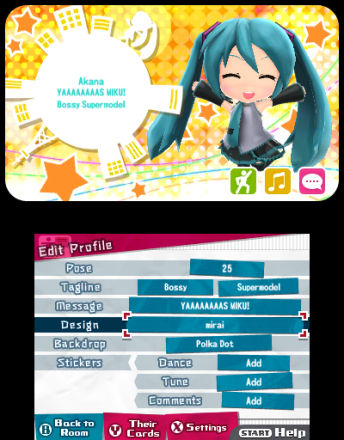
When you’re not playing the rhythm game, you have a lot of other things to do. When you start the game, you can pick one of the characters to be your partner (you can switch partners at any time). This character will live on the top screen on the main menu, as well as be available to spend time with in the accurately named “hang out mode.” You can play reversi Mikuversi with your partner, dress your partner up in wide variety of different outfits, take your partner shopping, change the design of your partner’s room, take your partner on vacation, write songs with your partner, and choreograph dances for your partner. There’s also an updated version of SEGA’s Puyo Puyo included with Project Mirai DX, which is kind of like Dr. Mario but with more of a focus on competition. In both Mikuversi and Puyo Puyo, the AI is well done, and can be set to either play nicely with you or completely crush you. Either way, it’s a lot of fun and I’ve spent more time losing Mikuversi to Luka than I’d care to admit. Playing with choreography and customizing your StreetPass card with custom songs and video comments is a lot of fun. You can dive deep into creating your own choreography for songs with an advanced mode, or you can easily create dances with a simpler UI. The simple mode is easy and intuitive, and it makes the creation mode more accessible to beginners than the creation suites in the Project DIVA games.
There’s also a life-sim element to your partners, as they have certain needs. For example, you use your mirai points to give your partner an allowance. They then, over time, use those points to buy food and drinks. You can see how your partner spent their points and a short explanation (written “by” your partner) of why they made the purchase. It’s a cute touch that adds to the idea that these characters have personalities, and they still exist when you’re not playing. It might sound dull, but collecting clothing, trinkets, and keeping your partner happy is highly addicting, and you’ll find that the many other elements of Project Mirai DX are just as entertaining as the rhythm game.
If any of these features sound remotely interesting to you, you’ll have a great time with Project Mirai DX. Each part of the game is highly polished, and it’s easily the best rhythm game on Nintendo 3DS. Since the game has many facets, it’s enjoyable not just for fans of rhythm games, but to fans of games in general. You might get to a point where you get tired of playing the rhythm game, but you can easily find something else to do with Project Mirai DX until you’re itching to play through some more songs (which won’t take too long). If you’re on the fence, you can watch some videos and play the free demo that’s available on the Nintendo eShop, but the only way you’ll get the full effect of Project Mirai DX is by playing the full game. It’s an excellent title, and it’s well worth picking up. Even though it’s probably a bit different from the games you’re used to playing, give this one a try – you won’t regret it.
Gameplay - 9
Sound - 10
Visuals - 8.5
Replay Value - 10
9.4
AMAZING
Project Mirai DX is more than a great rhythm game - it's just an excellent game all-around. There's something for everybody here, and it won't take long to get hooked on this adorable experience.
 Load the Game Video Games, Reviews, Game News, Game Reviews & Game Video Trailers
Load the Game Video Games, Reviews, Game News, Game Reviews & Game Video Trailers
